Cross-Section Deformation Analysis and Visualization of Shield Tunnel Based on Mobile Tunnel Monitoring System
Abstract
1. Introduction
2. The Mobile Tunnel Monitoring System
2.1. Integrated System Hardware
2.2. System Software Implementation
3. Methods
3.1. Deformation Analysis Method
3.1.1. Denoising
3.1.2. Calculation of Deformation
3.2. Projected Images Generation Method
3.2.1. Calculation of Fitted Circle Parameters
3.2.2. Projection of Tunnel Point Clouds
3.2.3. Generation of Images
3.3. Deformation Visualization
4. Method Validation
4.1. Data Sources
4.1.1. Chengdu Data Set
4.1.2. Tianjin Data Set
4.2. Validation of Accuracy of CNU-TS-2 by Total Station
4.3. Validation of Deformation Analysis and Visualization Method
4.3.1. Validation of Deformation Analysis Repeatability
4.3.2. Projected Images Quality Evaluation
- 1.
- Subjective Evaluation
- 2.
- Objective Evaluation
- (1)
- Mean
- (2)
- Standard Deviation
- (3)
- Average Gradient
4.3.3. Analysis of Deformation Visualization
5. Results
6. Discussion and Conclusions
Author Contributions
Funding
Acknowledgments
Conflicts of Interest
Appendix A
References
- The Statistical Bulletin on the Development of the Transportation Industry in 2018. Available online: http://xxgk.mot.gov.cn/jigou/zhghs/201904/t20190412_3186720.html (accessed on 24 December 2019).
- Xu, Z. Data Processing of Tunnel Engineering Deformation Monitoring. Master’s Thesis, Tongji University, Shanghai, China, 2009. [Google Scholar]
- Chen, M. Research on Mass Data Processing and Application of Laser Scanning in Subway Shield Tunnel. Master’s Thesis, Beijing Jiaotong University, Beijing, China, 2016. [Google Scholar]
- Wang, T.T.; Jaw, J.J.; Chang, Y.H.; Jeng, F.S. Application and validation of profile–image method for measuring deformation of tunnel wall. Tunn. Undergr. Space Technol. 2009, 24, 136–147. [Google Scholar] [CrossRef]
- Yun, L. Study on Qualitative Evaluation of Map Quality Base on Vague Set. Build. Superv. Cost 2015, 8, 33–49. [Google Scholar]
- Amberg Clearance GRP 5000. Available online: https://ambergtechnologies.com/solutions-services/amberg-rail/grp-system-fx/ (accessed on 19 November 2019).
- Leica SiTrack: One. Available online: https://leica-geosystems.com/products/mobile-sensor-platforms/capture-platforms/sitrack_one (accessed on 19 November 2019).
- Cui, H.; Ren, X.; Mao, Q.; Wang, W. Shield subway tunnel deformation detection based on mobile laser scanning. Autom. Constr. 2019, 106, 102889. [Google Scholar] [CrossRef]
- Nuttens, T.; Stal, C.; De Backer, H.; Schotte, K.; Van Bogaert, P.; De Wulf, A. Methodology for the ovalization monitoring of newly built circular train tunnels based on laser scanning. Autom. Constr. 2014, 43, 1–9. [Google Scholar] [CrossRef]
- Xie, X.; Lu, X. Development of a 3D modeling algorithm for tunnel deformation monitoring based on terrestrial laser scanning. Undergr. Space 2017, 2, 16–29. [Google Scholar] [CrossRef]
- Xu, X.; Yang, H.; Neumann, I. A feature extraction method for deformation analysis of large-scale composite structures based on TLS measurement. Compos. Struct. 2018, 184, 591–596. [Google Scholar] [CrossRef]
- Kang, Z.; Zhang, L.; Tuo, L.; Wang, B.; Chen, J. Continuous extraction of subway tunnel cross- sections based on terrestrial point clouds. Remote Sens. 2014, 6, 857–879. [Google Scholar] [CrossRef]
- Du, L.; Zhong, R.; Sun, H. Tunnel Cross Section Extraction and Deformation Analysis Based on Mobile Laser Scanning Technology. Surv. Mapp. 2018, 6, 61–67. [Google Scholar]
- Kang, Z.; Zlatanova, L.S. Continuously Deformation Monitoring of Subway Tunnel Based on Terrestrial Point Clouds. Remote Sens. Spat. Inf. Sci. 2012, 199–203. [Google Scholar] [CrossRef]
- Lindenbergh, R.; Pfeifer, N.; Rabbani, T. Accuracy analysis of the Leica HDS3000 and feasibility of tunnel deformation monitoring. In Proceedings of the ISPRS Workshop on Laser Scanning, ITC, Enschede, The Netherlands, 12–14 September 2005. [Google Scholar]
- Delaloye, D. Development of a New Methodology for Measuring Deformation in Tunnels and Shafts with Terrestrial Laser Scanning (LIDAR) Using Elliptical Fitting Algorithms. Master’s Thesis, Queen’s University, Kingston, ON, Canada, 2012. [Google Scholar]
- Walon, G.; Delaloye, D.; Diederichs, M.S. Development of an elliptical fitting algorithm to improve change detection capabilities with applications for deformation monitoring in circular tunnels and shafts. Tunn. Undergr. Space Technol. 2014, 43, 336–349. [Google Scholar] [CrossRef]
- Li, C.; Lu, X.; Zhu, N.; Lu, Y.; Wu, Y.; Li, G. Continuously Extracting Section and Deformation Analysis for Sunway Tunnel Based on LIDAR Points. Acta Geod. Cartogr. Sin. 2015, 44, 1056–1062. [Google Scholar]
- Jian, L.; Wan, Y.; Jiang, M. Tunnel Deformation Monitoring Based on the Terrestrial Laser Scanning Technology. Geospat. Inf. 2012, 10, 14–17. [Google Scholar]
- Xie, X.; Lu, X.; Tian, H.; Ji, Q.; Li, P. Development of a modeling method for monitoring tunnel deformation based on terrestrial 3D laser scanning. Chin. J. Rock Mech. Eng. 2013, 11, 2214–2224. [Google Scholar]
- Li, J. Horizontal chord lenth testing of single circle shield tunnel based on point clouds. J. Zhejiang Univ. Water Resour. Electr. Power 2015, 27, 53–59. [Google Scholar]
- Zhang, L.; Cheng, X. Tunnel Deformation Analysis Based on Lidar Points. Chin. J. Lasers 2018, 45, 0404004-1–0404004-6. [Google Scholar]
- Liu, G.; Xu, Y.; Bai, W. A Method to Determine the Deformation of Tunnel Section. Surv. Mapp. 2016, 2, 103–106. [Google Scholar]
- Zhang, F. Data processing and visualization analysis method of tunnel segment structure deformation based on laser scanning. Mod. Tunn. Technol. 2018, 55, 1043–1050. [Google Scholar]
- Wang, L.; Cheng, X.; Wang, C. Study on the 3D laser scanning technology for tunnel inspection. Geotech. Investig. Surv. 2013, 41, 53–57. [Google Scholar]
- Lin, Y. Research on Key Technology of Tunnel Point Cloud Data Processing and Visualization. Master’s Thesis, East China University of Technology, Wuzhou, China, 2017. [Google Scholar]
- Stios, S.; Kontogianni, V. Mean deformation tensor and mean deformation ellipse of an excavated tunnel section. Int. J. Rock Mech. Min. Sci. 2009, 46, 1306–1314. [Google Scholar]
- Fischler, M.A.; Bolles, R.C. Random Sample Consensus: A Paradigm for Model Fitting with Applications to Image Analysis and Automated Cartography. Commun. ACM 1981, 24, 381–395. [Google Scholar] [CrossRef]
- Ministry of Housing and Urban-Rural Construction of the People’s Republic of China. The Technical Specification for Urban Rail Transit Engineering Monitoring; China Architecture & Building Press: Beijing, China, 2014.
- Chen, H.; Li, N.; Wang, X.; Guo, X. Introduction to Digital Media Technology, 1st ed.; Beijing University of Posts and Telecommunications Press: Beijing, China, 2015; pp. 25–26. [Google Scholar]
- Yao, F.; Shao, G.; Takaue, R.; Tamaki, A. Automatic Concrete Tunnel Inspection Robot System. Adv. Robot. 2003, 17, 319–337. [Google Scholar] [CrossRef]
- Yu, S.N.; Jang, J.H.; Han, C.S. Auto Inspction System Using a Mobile Robot for Detecting Concrete Cracks in a Tunnel. Autom. Constr. 2007, 16, 255–261. [Google Scholar] [CrossRef]
- Puente, I.; Gonzalez-Jorge, H.; Martinez-Sanchez, J.; Arias, P. Automatic Detection of Road Tunnel Luminaires Using a Mobile LiDAR System. Measurement 2014, 47, 569–575. [Google Scholar] [CrossRef]
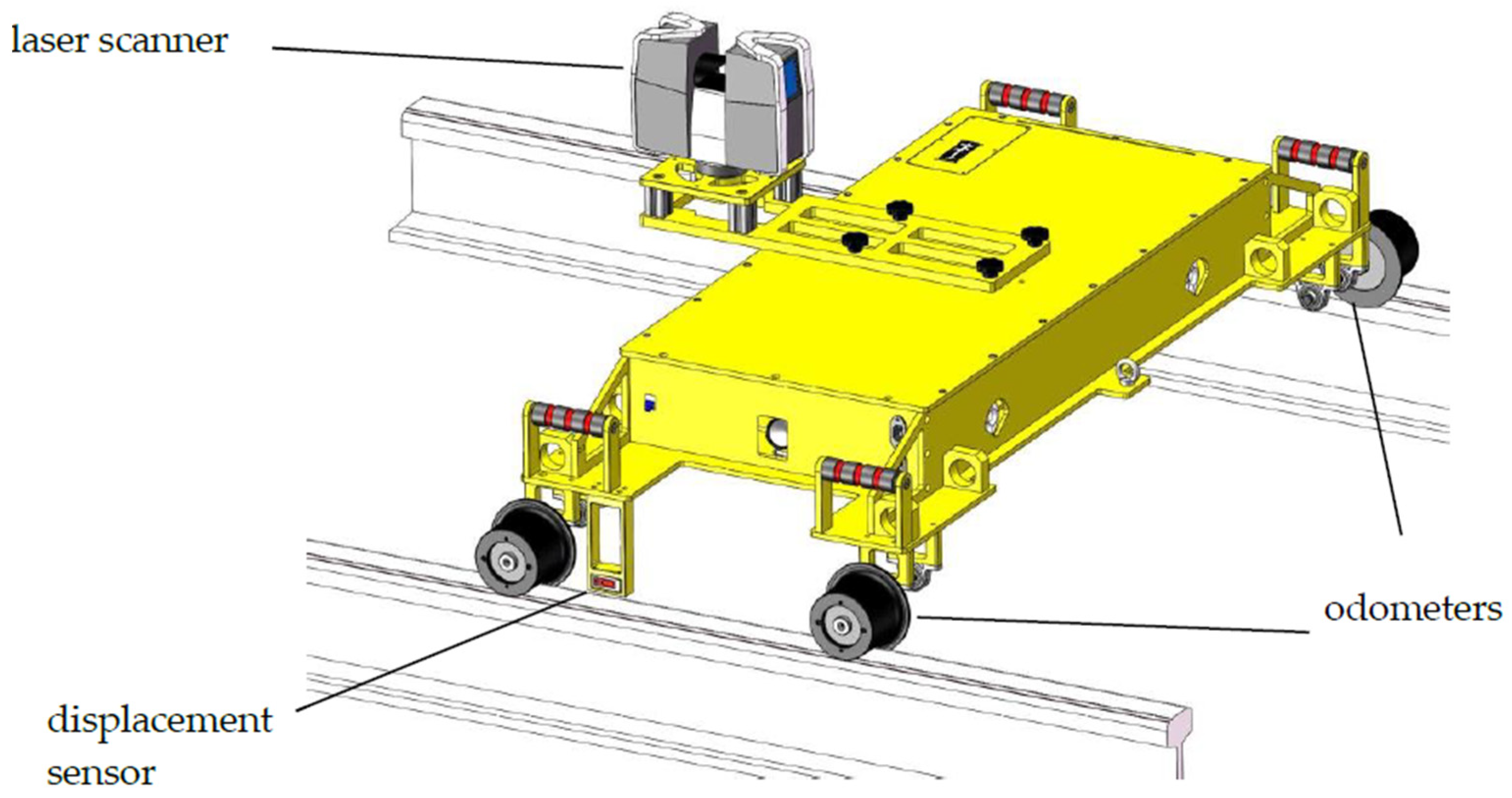
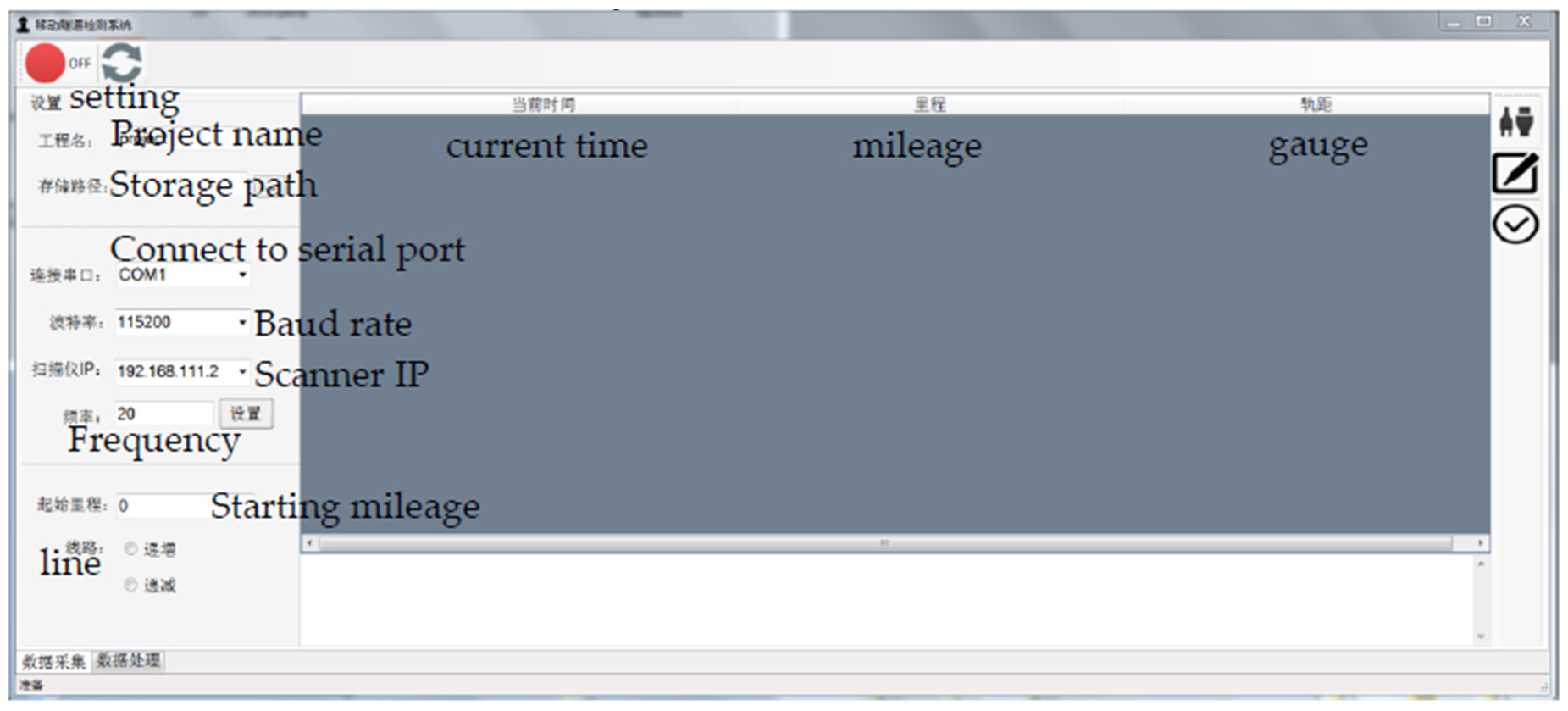


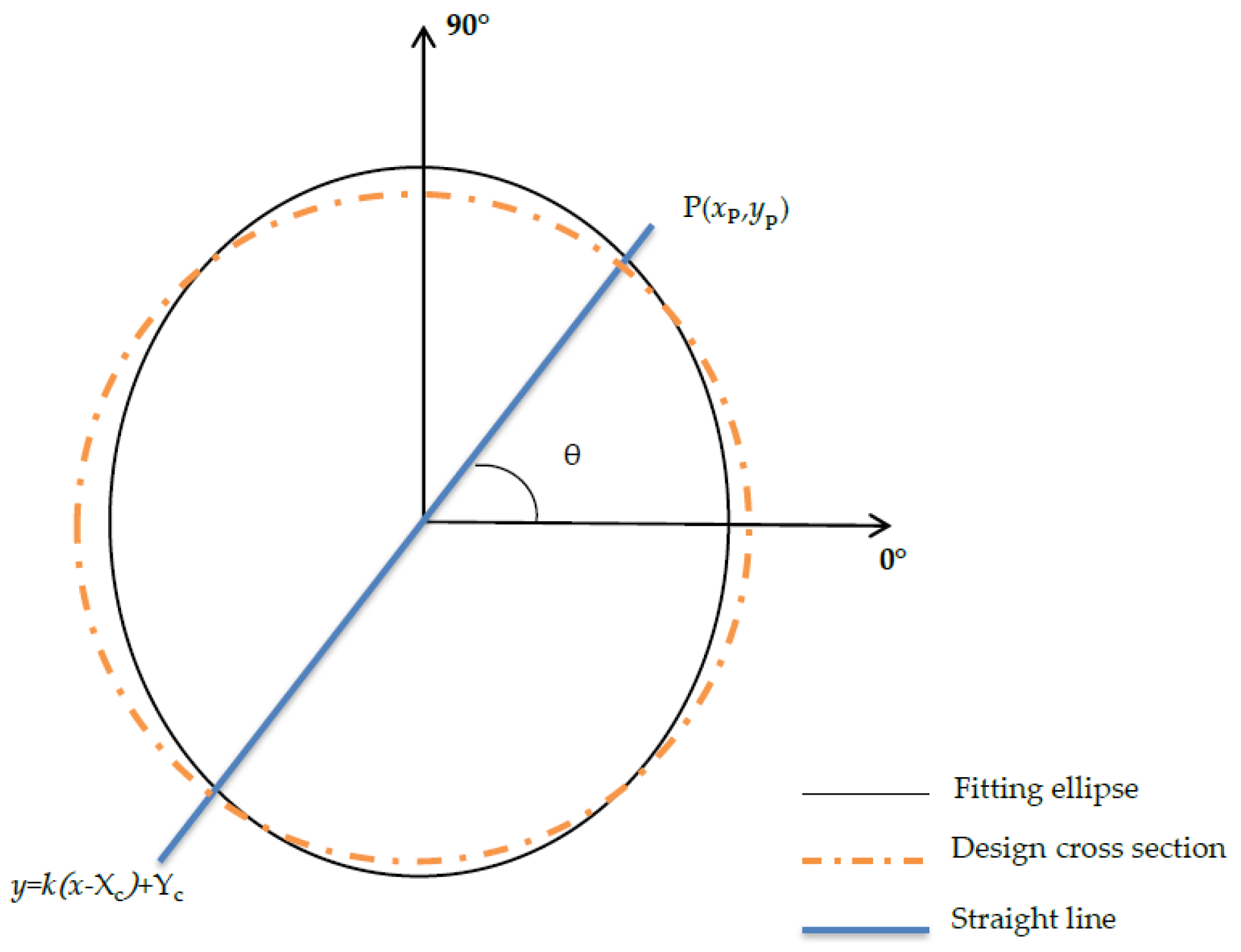
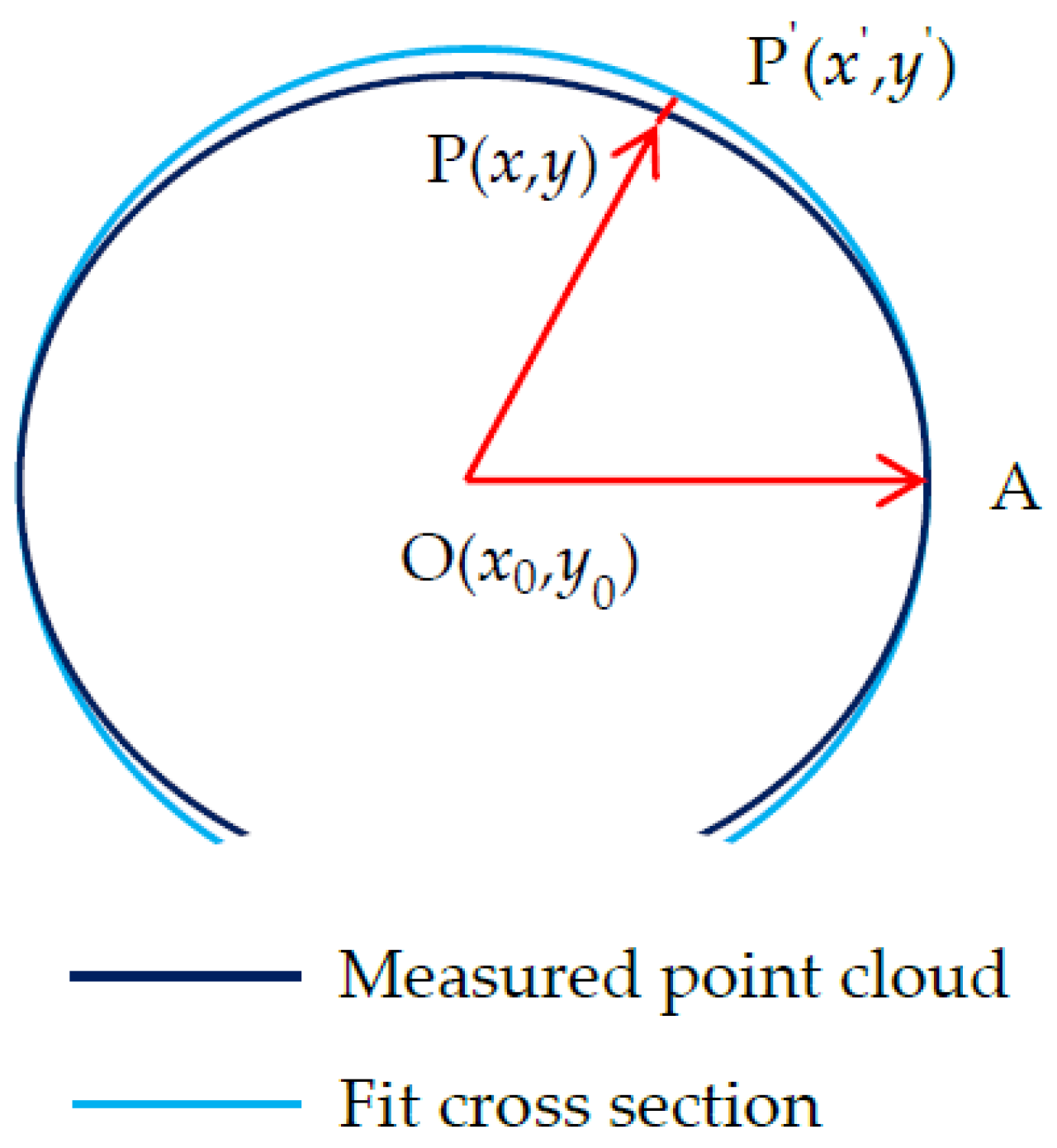

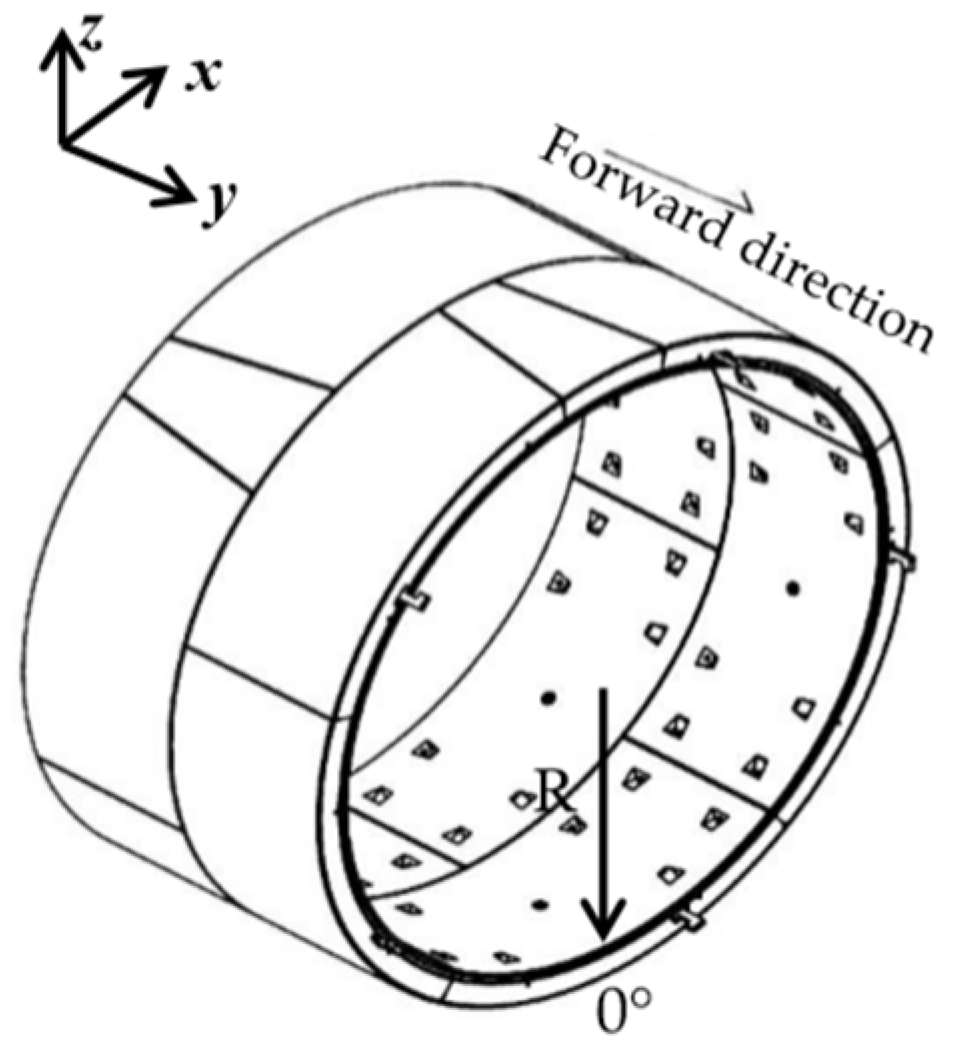
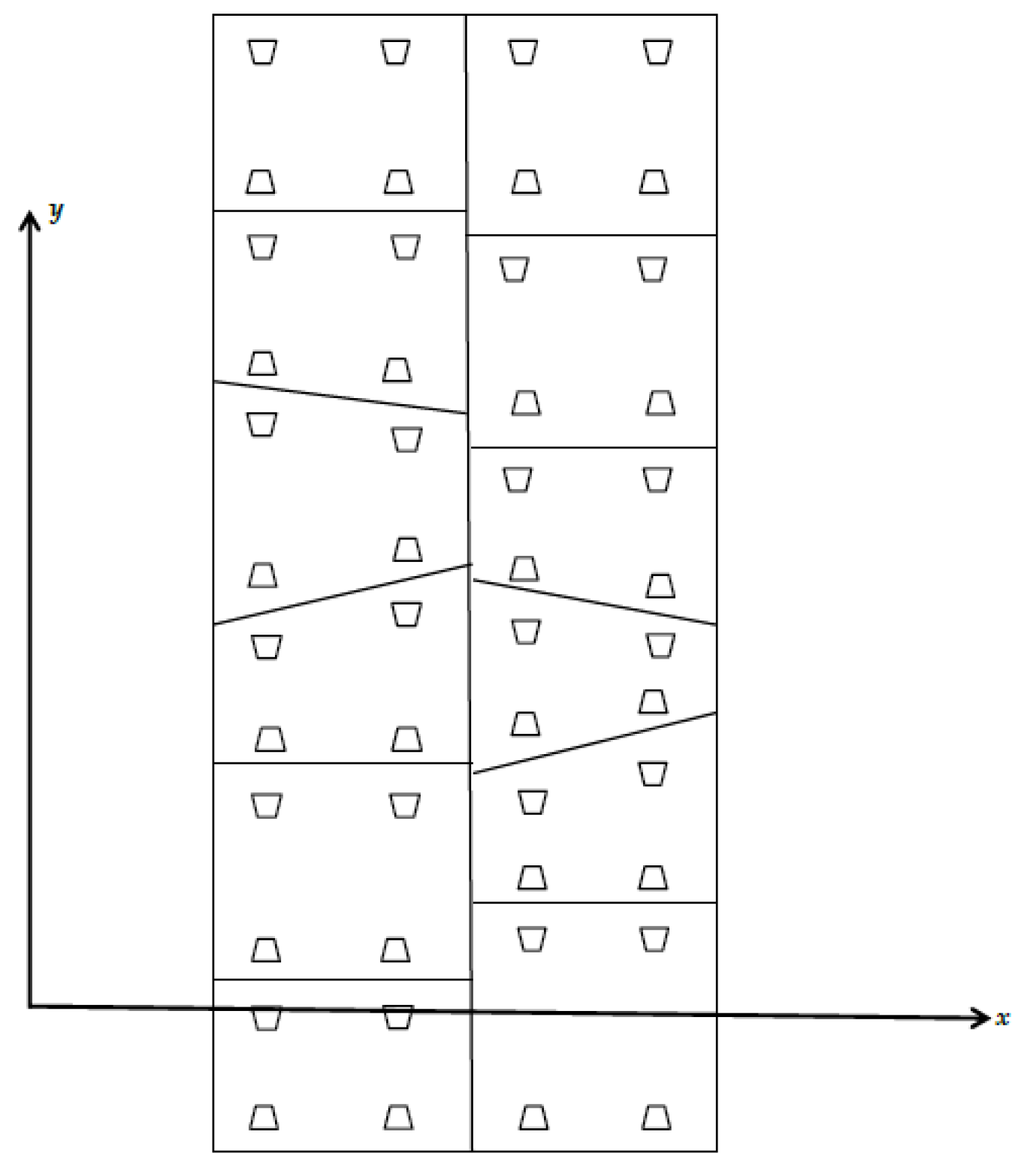
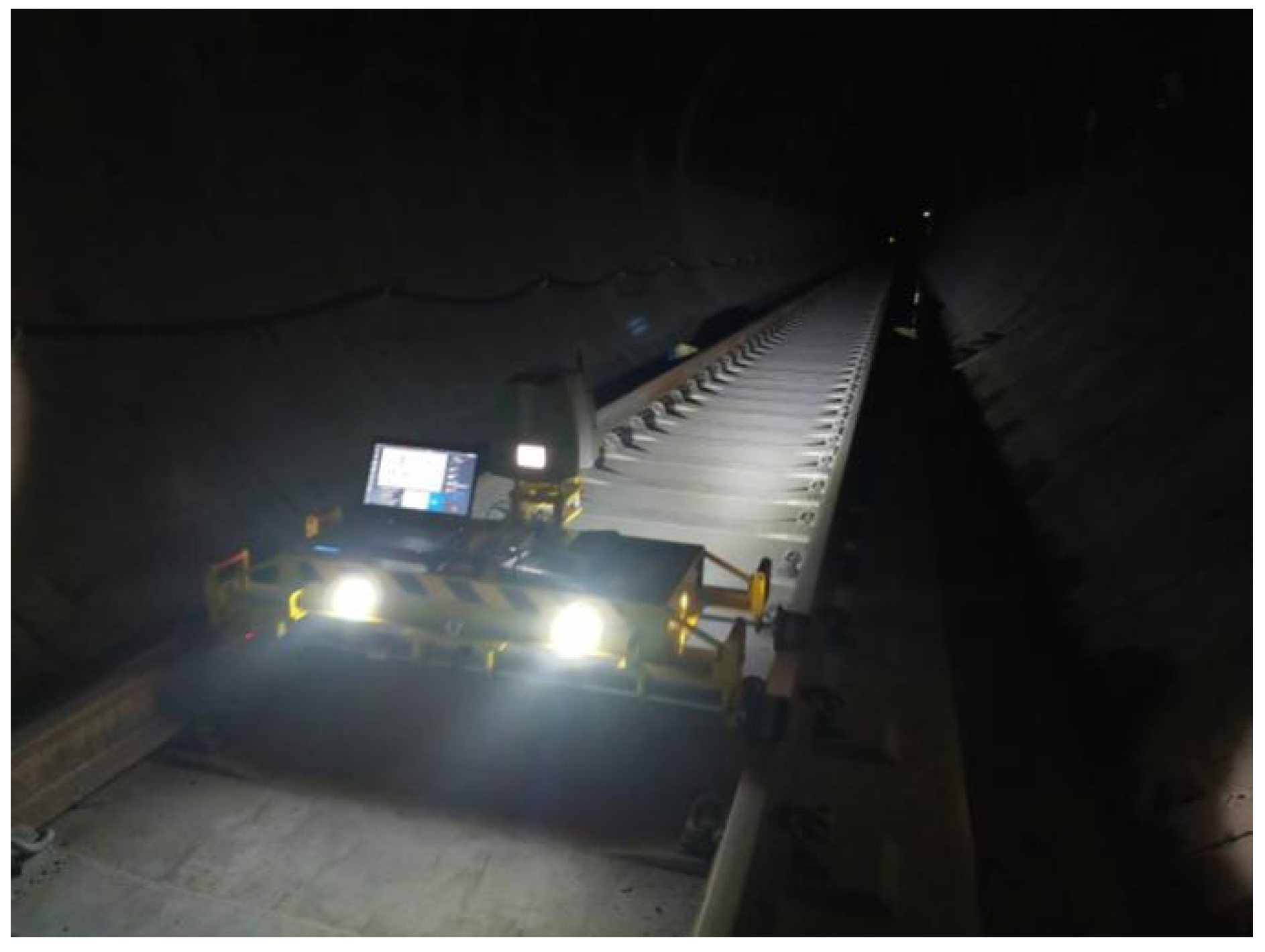
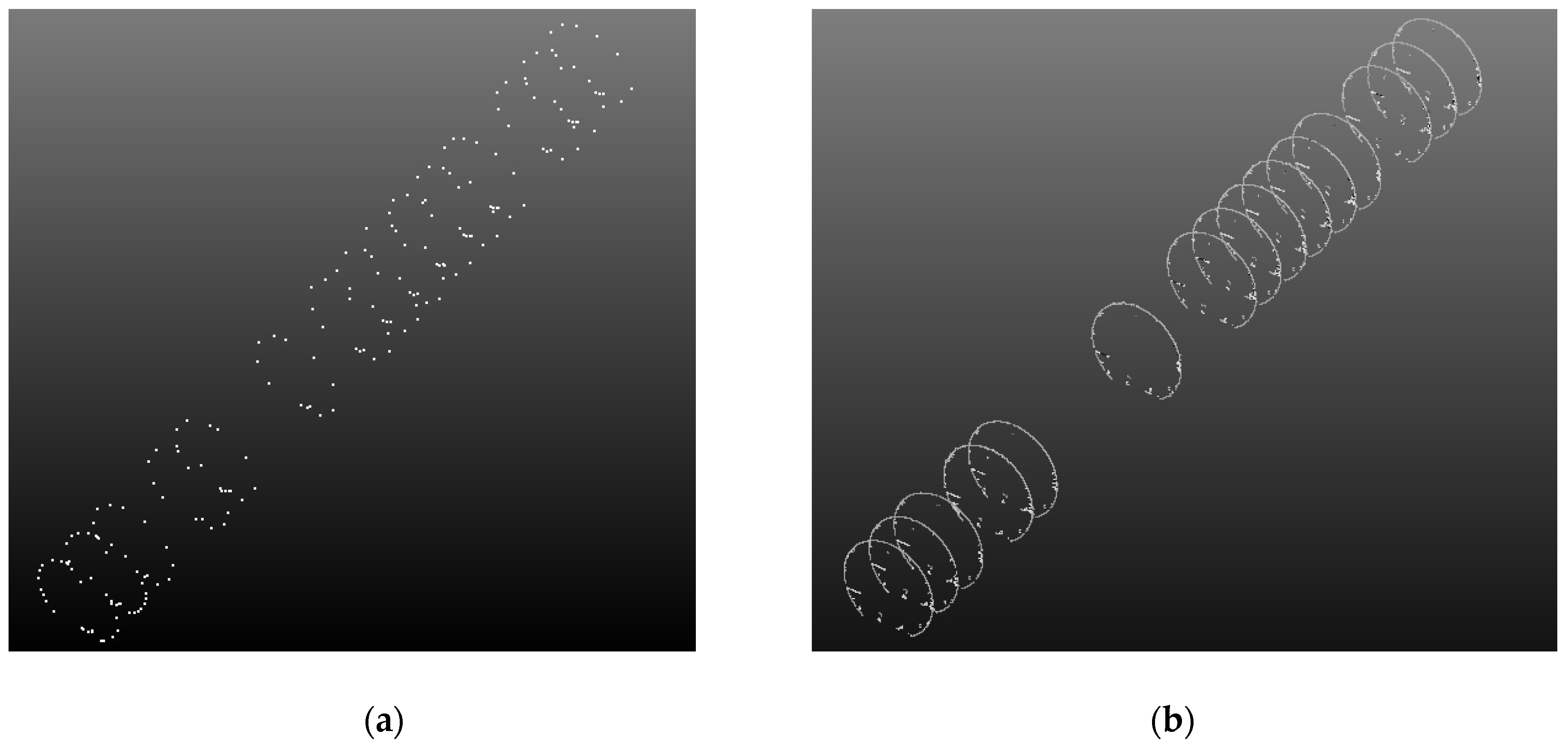
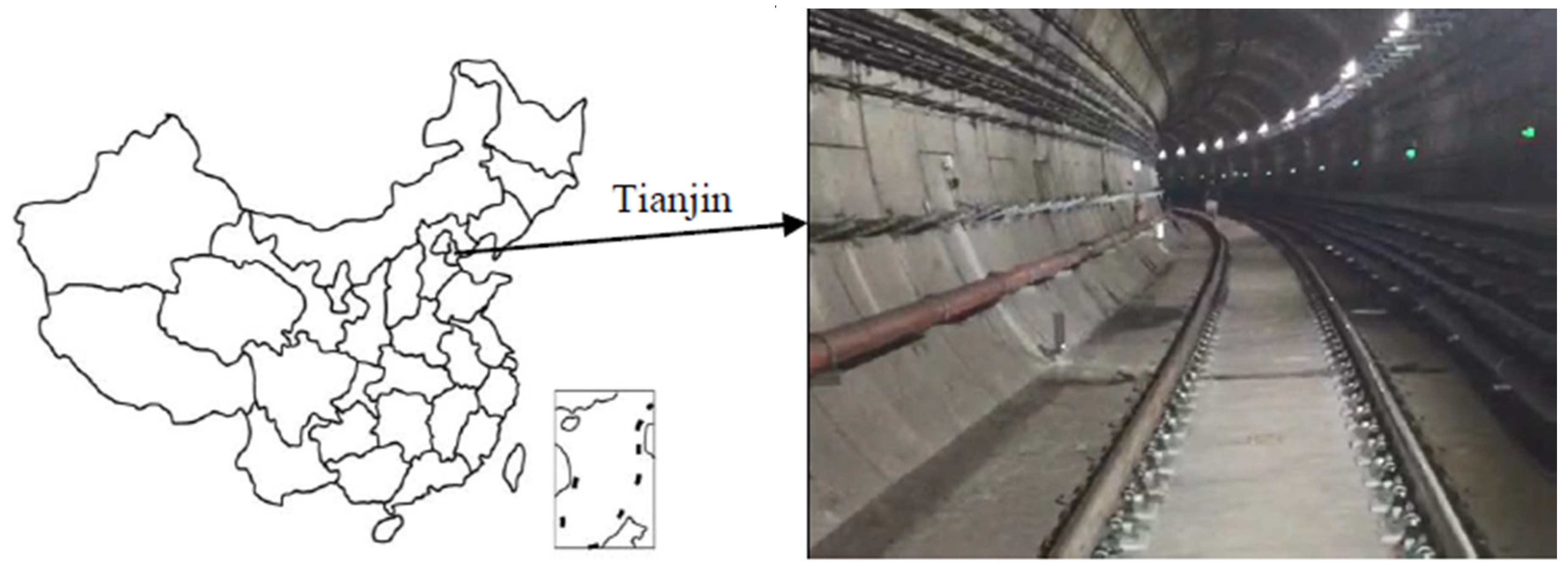
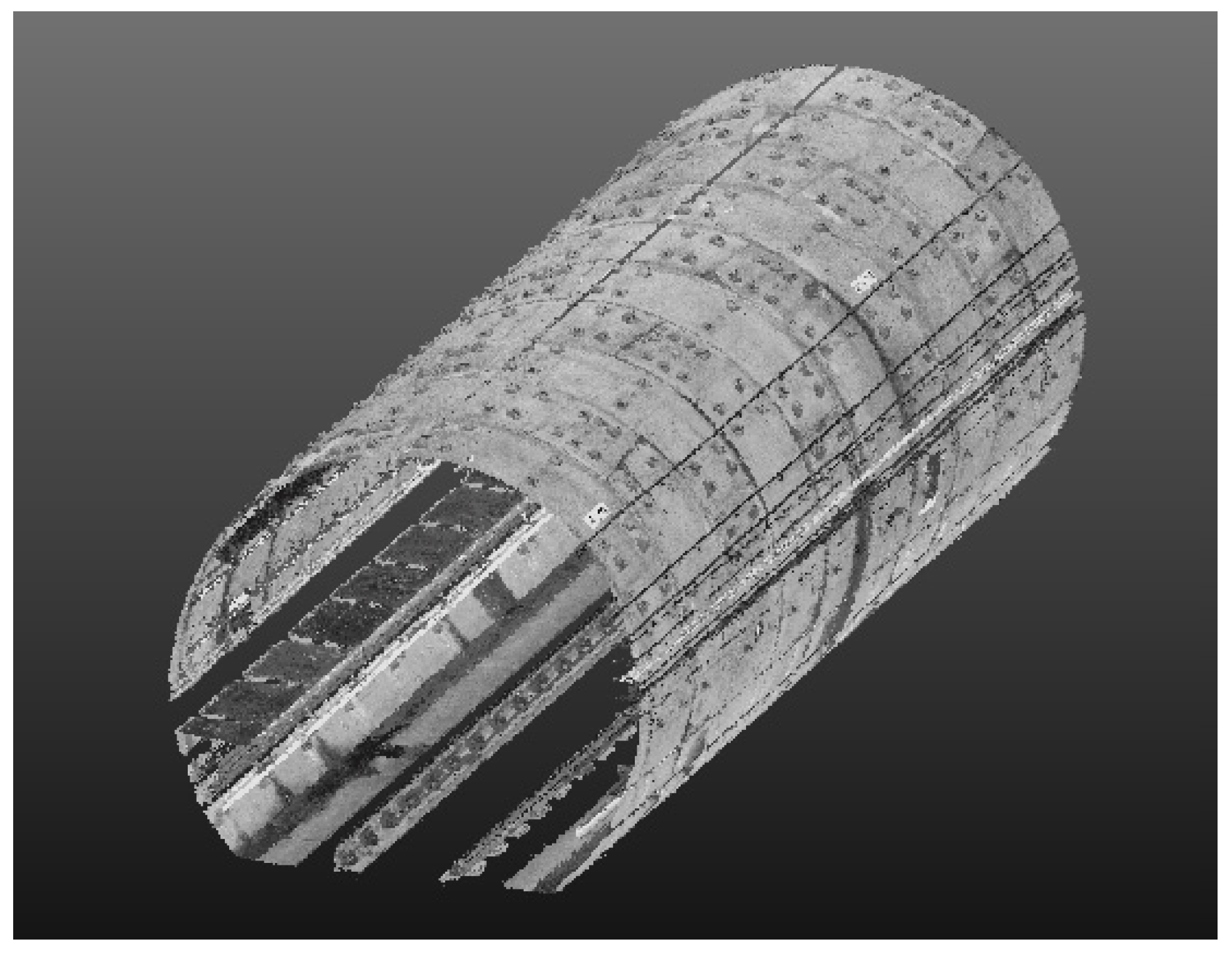
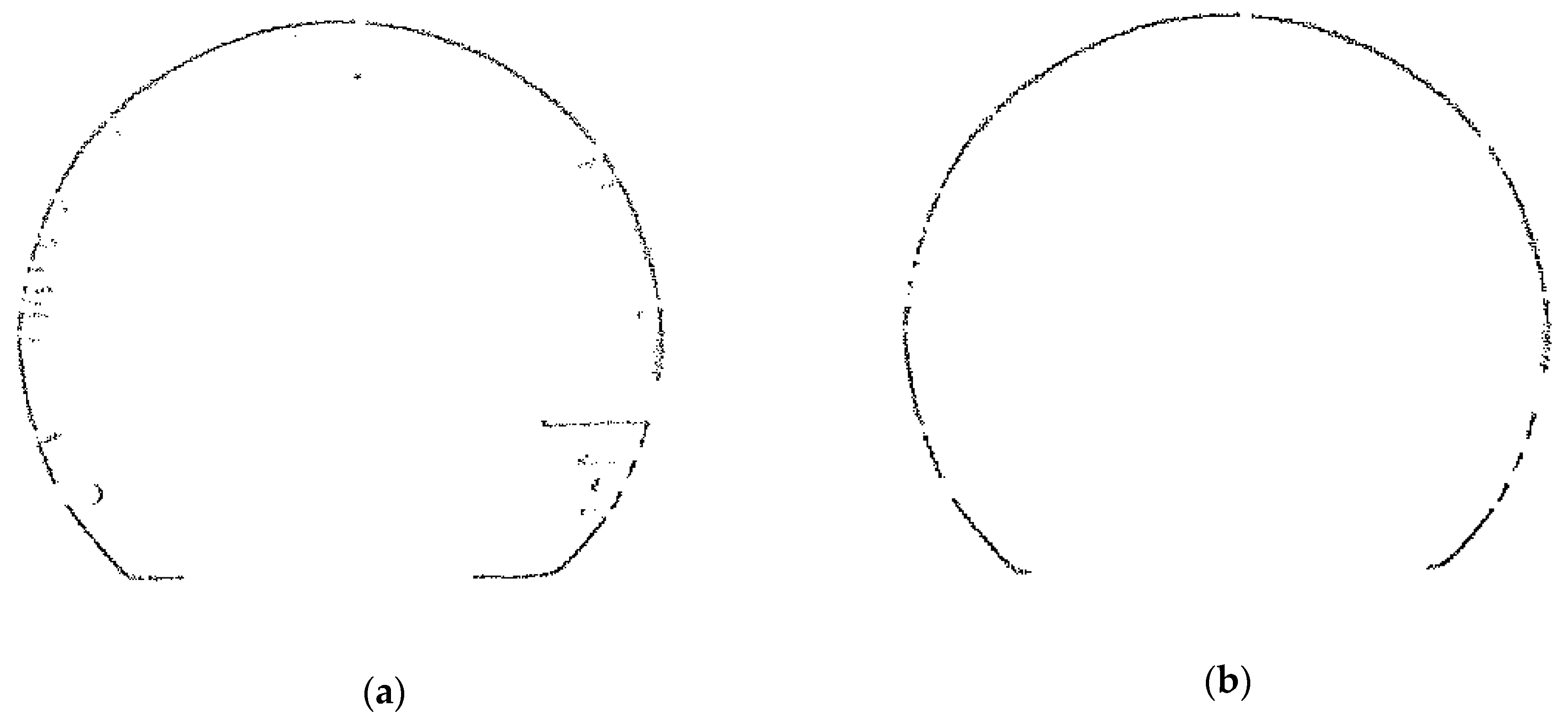



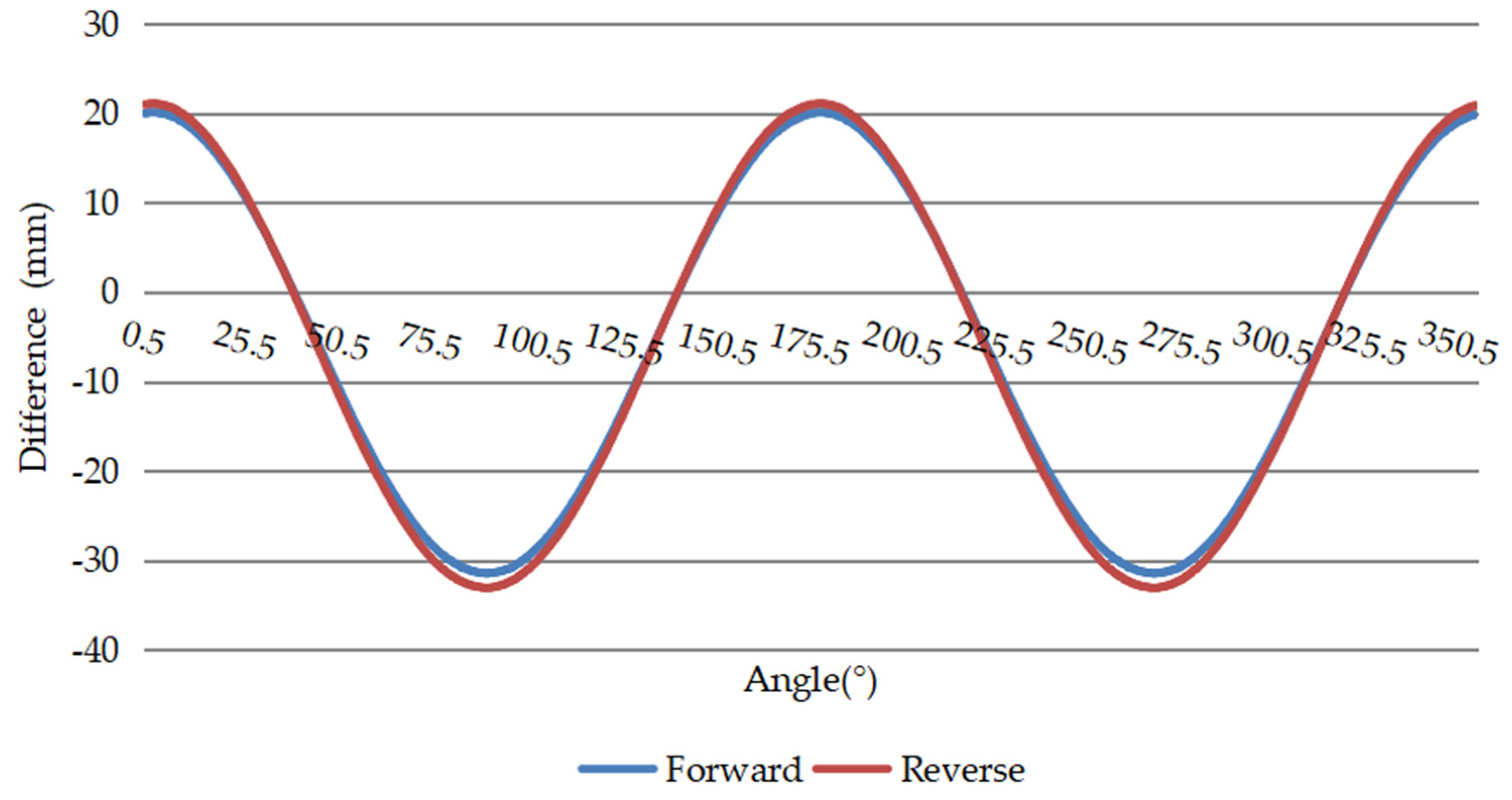
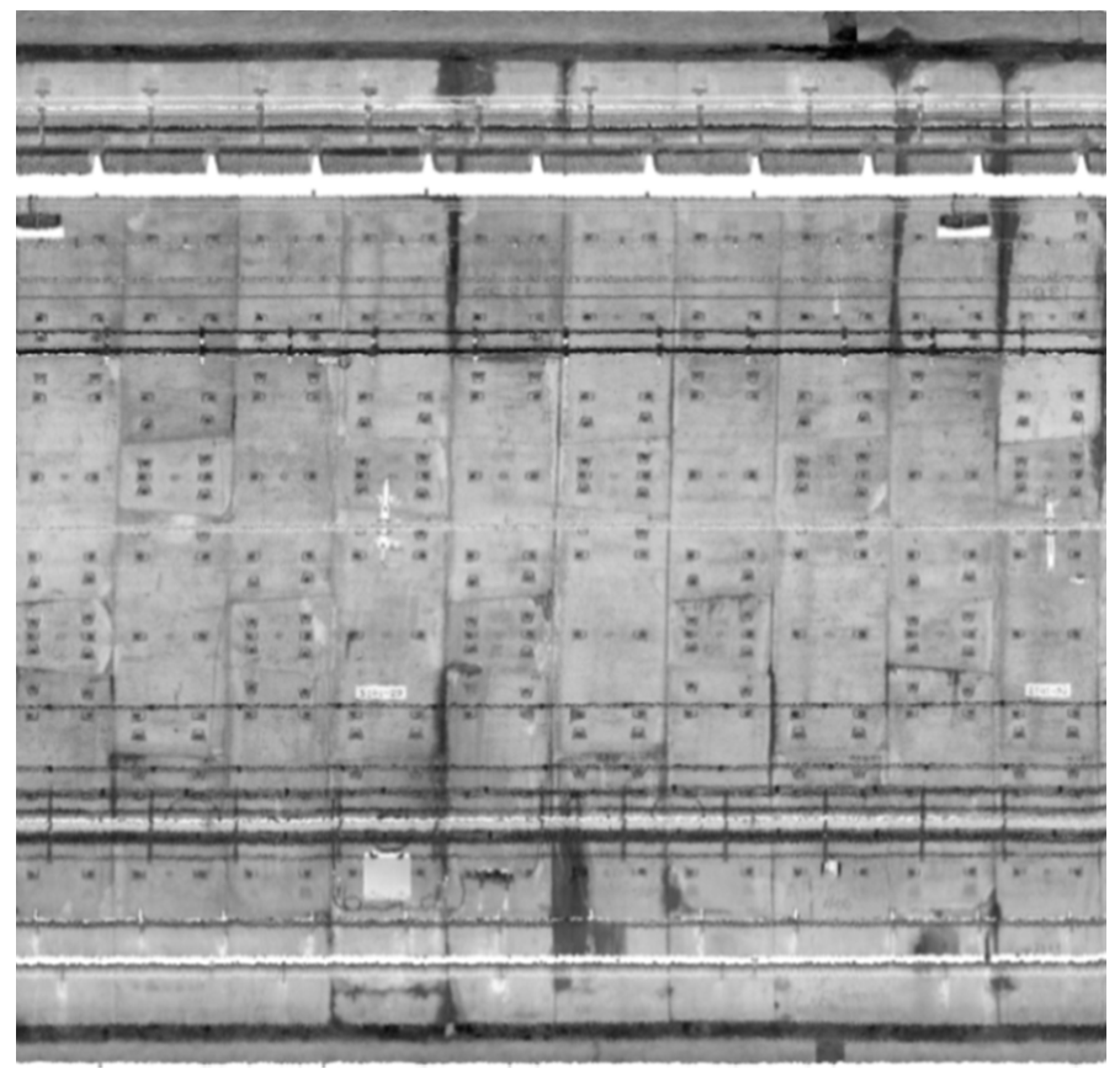

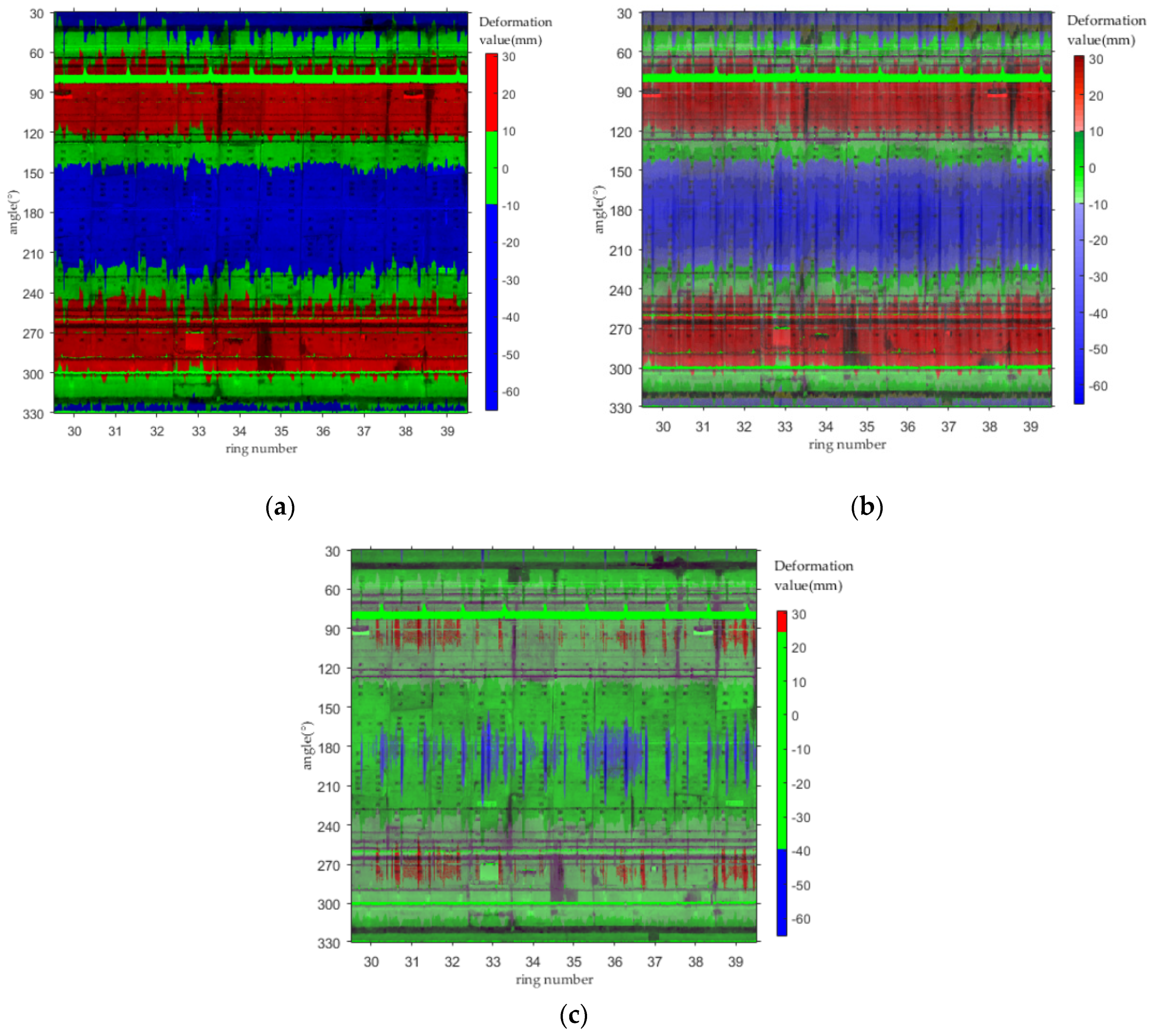
| Name | Ranging Accuracy | Scan Speed (points/s) | Angle Measurement Accuracy | Vertical Field of View |
|---|---|---|---|---|
| Faro Focus 3D 120 | ±2 mm | 97,600 | 0.009°/0.009° | 300° |
| Leica ScanStation P30/P40 | ±1.2 mm | 1,000,000 | 0.002°/0.002° | 290° |
| Z + F IMAGER 5016 | ±1 mm | 1,100,000 | 0.004°/0.004° | 320° |
| Ring Number | Diameter: Total Station (m) | Diameter: CNU-TS-2 (m) | Absolute Deviation (mm) |
|---|---|---|---|
| 1 | 5.4133 | 5.4153 | 2.0 |
| 2 | 5.4139 | 5.4131 | 0.8 |
| 3 | 5.4158 | 5.4134 | 2.4 |
| 4 | 5.4105 | 5.4096 | 0.9 |
| 5 | 5.4144 | 5.4154 | 1.0 |
| 6 | 5.4162 | 5.4147 | 1.5 |
| 7 | 5.4141 | 5.4126 | 1.5 |
| 8 | 5.4138 | 5.4152 | 1.4 |
| 9 | 5.4139 | 5.4133 | 0.6 |
| 10 | 5.4136 | 5.4157 | 2.1 |
| 11 | 5.4134 | 5.4155 | 2.1 |
| 12 | 5.4084 | 5.4093 | 0.9 |
| 13 | 5.4137 | 5.4118 | 1.9 |
| 14 | 5.4155 | 5.4156 | 0.1 |
| 15 | 5.4139 | 5.4133 | 0.6 |
| Quality Scale | Obstacle Scale | ||
|---|---|---|---|
| 5 points | No image degradation is noticed | 5 | Very good |
| 4 points | Can see changes in image quality without hindering viewing | 4 | Good |
| 3 points | It is clear that the image quality has deteriorated, which slightly hinders viewing | 3 | Common |
| 2 points | Obstructs viewing | 2 | Bad |
| 1 points | Very serious hindrance to viewing | 1 | Very bad |
© 2020 by the authors. Licensee MDPI, Basel, Switzerland. This article is an open access article distributed under the terms and conditions of the Creative Commons Attribution (CC BY) license (http://creativecommons.org/licenses/by/4.0/).
Share and Cite
Sun, H.; Liu, S.; Zhong, R.; Du, L. Cross-Section Deformation Analysis and Visualization of Shield Tunnel Based on Mobile Tunnel Monitoring System. Sensors 2020, 20, 1006. https://doi.org/10.3390/s20041006
Sun H, Liu S, Zhong R, Du L. Cross-Section Deformation Analysis and Visualization of Shield Tunnel Based on Mobile Tunnel Monitoring System. Sensors. 2020; 20(4):1006. https://doi.org/10.3390/s20041006
Chicago/Turabian StyleSun, Haili, Shuang Liu, Ruofei Zhong, and Liming Du. 2020. "Cross-Section Deformation Analysis and Visualization of Shield Tunnel Based on Mobile Tunnel Monitoring System" Sensors 20, no. 4: 1006. https://doi.org/10.3390/s20041006
APA StyleSun, H., Liu, S., Zhong, R., & Du, L. (2020). Cross-Section Deformation Analysis and Visualization of Shield Tunnel Based on Mobile Tunnel Monitoring System. Sensors, 20(4), 1006. https://doi.org/10.3390/s20041006





